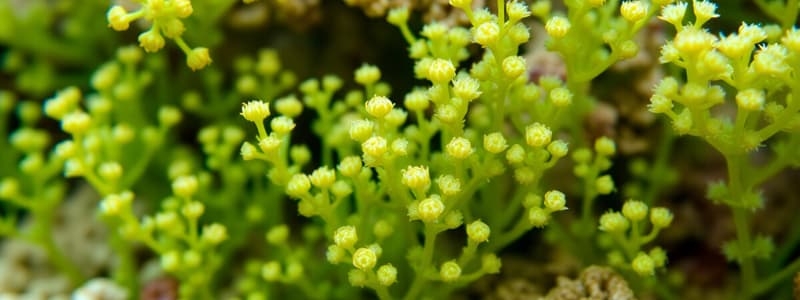Podcast
Questions and Answers
What is a primary threat to marine plants caused by human activity?
What is a primary threat to marine plants caused by human activity?
- Climate change (correct)
- Natural disasters
- Lack of sunlight
- Invasive species
How does overfishing indirectly impact marine plant communities?
How does overfishing indirectly impact marine plant communities?
- By reducing populations of herbivores that manage algal growth (correct)
- By enhancing nutrient cycling in the ocean
- By increasing the growth of seagrass beds
- By promoting biodiversity in plant species
Which aspect of marine plants makes them significant in tracking environmental health?
Which aspect of marine plants makes them significant in tracking environmental health?
- They are located in shallow water only.
- They are good indicators of water quality changes. (correct)
- They possess high economic value.
- They do not support diverse marine life.
What is a consequence of habitat destruction on marine plants?
What is a consequence of habitat destruction on marine plants?
What type of factors can cause diseases in marine plants?
What type of factors can cause diseases in marine plants?
Which group of marine plants is primarily responsible for oxygen production in marine ecosystems?
Which group of marine plants is primarily responsible for oxygen production in marine ecosystems?
What is a unique adaptation that seagrasses possess for survival in their marine environment?
What is a unique adaptation that seagrasses possess for survival in their marine environment?
Which of the following statements about mangroves is true?
Which of the following statements about mangroves is true?
What is the primary role of macroalgae in marine ecosystems?
What is the primary role of macroalgae in marine ecosystems?
Which marine plant is known for providing critical shelter and nursery grounds for juvenile marine organisms?
Which marine plant is known for providing critical shelter and nursery grounds for juvenile marine organisms?
What mechanism allows phytoplankton to remain suspended in the water column?
What mechanism allows phytoplankton to remain suspended in the water column?
Which of the following is NOT a role of marine plants in their ecosystems?
Which of the following is NOT a role of marine plants in their ecosystems?
What type of algae includes larger forms such as kelp and seaweed?
What type of algae includes larger forms such as kelp and seaweed?
Flashcards
What are marine plants?
What are marine plants?
Photosynthetic organisms that live in saltwater environments, providing food and habitat for other marine creatures.
What are the types of marine plants?
What are the types of marine plants?
Diverse marine plants encompassing microscopic algae to large kelp forests.
What are phytoplankton?
What are phytoplankton?
Microscopic algae found drifting in the water column, forming the base of the marine food web.
What are macroalgae?
What are macroalgae?
Signup and view all the flashcards
What are seagrasses?
What are seagrasses?
Signup and view all the flashcards
What are mangroves?
What are mangroves?
Signup and view all the flashcards
What are adaptations of marine plants?
What are adaptations of marine plants?
Signup and view all the flashcards
What are ecological roles of marine plants?
What are ecological roles of marine plants?
Signup and view all the flashcards
Pollution's Impact on Marine Plants
Pollution's Impact on Marine Plants
Signup and view all the flashcards
Habitat Destruction of Marine Plants
Habitat Destruction of Marine Plants
Signup and view all the flashcards
Climate Change on Marine Plants
Climate Change on Marine Plants
Signup and view all the flashcards
Overfishing Impacts Marine Plants
Overfishing Impacts Marine Plants
Signup and view all the flashcards
Disease Threat to Marine Plants
Disease Threat to Marine Plants
Signup and view all the flashcards
Study Notes
Introduction to Marine Plants
- Marine plants are photosynthetic organisms that live in saltwater environments.
- They play crucial roles in marine ecosystems, providing food and habitat for a wide variety of animals.
- They are a vital part of the ocean's food web.
- Marine plants come in diverse forms, ranging from microscopic algae to large seagrass meadows.
Types of Marine Plants
- Algae: These are the most diverse group of marine plants, encompassing various types, including:
- Phytoplankton: Microscopic algae that float in the water column. Crucial for the base of the marine food web.
- Macroalgae: Larger forms of algae, like kelp, seaweeds, and nori. Often found in shallow coastal waters.
- Seagrasses: These are flowering plants adapted to marine environments. They have roots, stems, and leaves and form extensive meadows in shallow, coastal areas.
- Mangroves: These are trees or shrubs that grow in coastal saline or brackish water. While technically not aquatic plants, they have adaptations for survival in such environments and provide essential habitat.
Adaptations to Marine Environments
- Marine plants have unique adaptations to survive in salt water.
- Salt tolerance: Mechanisms for regulating salt concentrations within their tissues.
- Anchoring: Specialized root systems for stabilizing in strong currents.
- Light penetration: Strategies for capturing sunlight in the water column, which becomes less available with depth.
- Phytoplankton possess tiny structures (e.g., air bladders) that allow them to float.
- Macroalgae exhibit varying structures, such as holdfasts and stipes, for attachment and support.
- Seagrasses and mangroves have specialized roots and stem structures for stability in shallow and often turbulent coastal waters.
Ecological Roles
- Habitat provision: Seagrass and mangrove beds provide critical shelter and nursery grounds for juvenile fish, invertebrates, and other marine organisms.
- Food source: Many marine organisms rely on marine plants as a primary food source.
- Oxygen production: Photosynthesis by marine plants releases oxygen, a crucial component for the aquatic ecosystem.
- Carbon sequestration: Marine plants help in removing atmospheric carbon dioxide.
- Coastal protection: Seagrass beds and mangroves act as natural buffers against erosion and storms.
Threats to Marine Plants
- Pollution: Chemical pollutants, sedimentation, and excess nutrients can harm marine plant communities.
- Habitat destruction: Coastal development, dredging, and boat traffic can destroy seagrass beds and mangrove forests.
- Climate change: Rising sea levels and increased ocean temperatures can negatively affect the distribution and abundance of marine plants.
- Overfishing: This can indirectly impact marine plant communities, for example, by reducing populations of herbivores that control algal overgrowth.
- Disease: Diseases can affect plants in the same way and with similar intensity as other organisms.
Importance of Marine Plants
- Economic value: Several marine plants are harvested for food, medication, and other products.
- Biodiversity hotspots: They support unique and diverse communities of marine life.
- Water quality indicators: Changes in marine plant communities can signal changes in water quality.
Studying That Suits You
Use AI to generate personalized quizzes and flashcards to suit your learning preferences.




